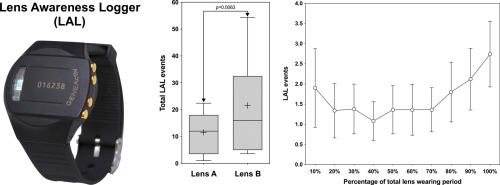Contact Lens & Anterior Eye ( IF 4.1 ) Pub Date : 2020-03-06 , DOI: 10.1016/j.clae.2020.02.010 Michael L Read 1 , Maria Navascues-Cornago 1 , Nancy Keir 2 , Carole Maldonado-Codina 1 , Philip B Morgan 1

|
Purpose
To investigate ocular discomfort during contact lens wear using a wrist-mounted electronic ‘lens awareness logger’ (LAL).
Methods
Thirty symptomatic contact lens wearers wore study contact lenses for three days. On the first two days, two lens types which are known to differ in end-of-day comfort (lens A: senofilcon A and lens B: balafilcon A), were worn as a matching pair (randomised order). On day three, a pair of lens B was worn. On each day, the participant used a LAL. On day one and two, the participant pressed a button on the LAL whenever they became aware of their lenses due to discomfort. On day three, the participant used a multiple click protocol (1 = mild awareness to 3 = severe awareness) to report discomfort.
Results
LAL events were similar on days one and two (17.3 vs. 15.8 events per day). There were significantly more LAL events for lens B (21.6 events per day) in comparison with lens A (11.6 events per day) (p = 0.006). The LAL event profile highlighted peaks in awareness following lens application and towards the end of the wearing cycle. Comparison of the LAL event profile for the two lens types showed significant differences in lens awareness, particularly in the first half of the wearing cycle. LAL events on day 3, showed a uniform distribution of single and double clicks through the day, but a marked peak in triple clicks in the last two hours of lens wear.
Conclusion
The LAL was able to differentiate between the study lenses and demonstrated differences in their LAL event profiles. Lens awareness associated with discomfort appeared to increase not only in frequency, but also in intensity towards the end of the wearing cycle. The ability of the LAL to track lens awareness suggests it is likely to be a useful tool in furthering understanding of ocular discomfort.
中文翻译:

使用腕戴式电子记录器监测眼部不适。
目的
使用腕戴式电子“镜片意识记录器”(LAL)调查佩戴隐形眼镜期间的眼部不适。
方法
30 名有症状的隐形眼镜佩戴者佩戴研究隐形眼镜三天。在前两天,已知在一天结束时的舒适度不同的两种镜片类型(镜片 A:senofilcon A 和镜片 B:balafilcon A)作为配对佩戴(随机顺序)。第三天,戴了一副镜片B。参与者每天都使用 LAL。在第一天和第二天,参与者在由于不适而意识到他们的镜片时按下 LAL 上的按钮。在第三天,参与者使用多次点击协议(1 = 轻度意识到 3 = 严重意识)报告不适。
结果
LAL 事件在第一天和第二天相似(每天 17.3 对 15.8 事件)。与晶状体 A(每天 11.6 个事件)相比,晶状体 B(每天 21.6 个事件)的 LAL 事件明显更多(p = 0.006)。LAL 事件概况突出了镜片应用后和佩戴周期结束时的意识峰值。两种镜片类型的 LAL 事件概况的比较显示镜片意识存在显着差异,尤其是在佩戴周期的前半段。第 3 天的 LAL 事件显示一天中单击和双击的均匀分布,但在镜片佩戴的最后两个小时内三次单击的显着峰值。
结论
LAL 能够区分研究镜头并证明其 LAL 事件概况的差异。与不适相关的镜片意识似乎不仅在频率上增加,而且在佩戴周期结束时强度也增加。LAL 跟踪晶状体意识的能力表明它可能是进一步了解眼部不适的有用工具。











































 京公网安备 11010802027423号
京公网安备 11010802027423号